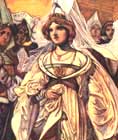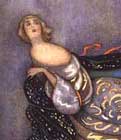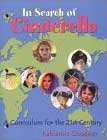
Cinderella:
345 Variants
by Marian
Roalfe Cox
SurLaLune's
Cinderella Area
SurLaLune Fairy Tales Main Page
57
Kolberg, O., Lud. Kieleckie (the People, Province of Kielce). Cracow, 1885-1886. Vol. ii, pp. 239-241.
"THE MYSTERIOUS LADY OF THE FIR-TREE."
ABSTRACT
Ill-treated heroine (by step-mother)--Menial heroine (tends cattle) -- Fir-tree-lady aid -- Magic dresses -- Meeting-place (church)--Threefold flight --Heroine throws soap and threads to make mist--Pitch trap--Lost shoe--Shoe marriage test-- Heroine hidden on stable-roof--Animal witness (cock)--[Story branches off into another.]
TABULATION
(1) Stepmother never allows heroine to go to church.-- (2) Once, whilst she is minding the cattle in the forest, a lady comes out of a fir-tree,1 gives her magnificent clothes, and promises to mind herd whilst she goes to church-- (3) A gentleman is greatly struck with her, but she twice escapes him by throwing behind her some soap and threads, which produce a mist. (The soap had been given her by the fir-tree lady, who is probably the Virgin.)-- (4) Gentleman causes tar to be spread, and heroine loses a shoe. Search is made for heroine, whom stepmother hides on stable-roof. Cock betrays the secret. [Here the story branches off into another direction, probably through confusion with some other tale.]
NOTES
Note 7
(P. 152.) A magic tree springs from some buried portion of the helpful animal in Nos. 52, 70, 101 (from three drops of sheep's blood), 102, 227, 228, 230, 232, 236, 242, 243, and 249; and from the buried mother in No. 95. In No. 101 the sheep, as in No. 102 the ox, is the mother transformed. In 233 the bones of helpful animal laid on pear-tree cause its branches to be decked with golden bells. (A house springs from the buried ox in No. 13.)
In a story from Abyssinia (Reinisch, Die Nuba Sprache, Vienna, 1879, I, 221) seven palm-trees grow on the spot where the girl buries the bones of her seven brothers. The mother is buried under a tree in No. 17, and help is obtained at her grave. A tree is planted on mother's grave in Nos. 19, 37, and 62. There is a treasure-tree in Nos. 13, 36, 38, 42, 47, 49, 52, 58, 61, 75, 77, 95, 96, 112, 126, 204, 242, 255, 306, and in the hero-tales 340 and 341; and a wishing-tree in Nos. 47 and 335. In No. 123 old man draws a tree which heroine must knock to get dresses, etc. In Nos. 7, 18, and 295 the heroine plants magical trees.
Cf. Gipsy-lore Journal, i, 84, "Tale of a Foolish Brother and of a Wonderful Bush"; Children's Legends, No. 10, "The Hazel Branch" (in Grimm's H. T.). For wishing-trees, cf. Dasent, liv, and pp. 420, 433; Grimm's "Juniper-tree"; and comp. the wishing-tree that bears clothes, trinkets, etc., and wine, in Meghadhuta (ed. Schutz, pp. 25-7), and the five trees in Indra's heavenly paradise which grant every wish. In Somadeva, 2, 84, we find the Indian's Kalpa Vriksha (tree of wishes), or Manoratha-dayaka (wish-giving). See Grimm, Teut. Myth., 872. In "Punchkin", the tree growing on mother's grave gives fruit. For speaking-trees, cf. Callaway, Zulu Folk-tales, p. 188; Dasent, pp. 113, 428, 440; Day, Folk-tales of Bengal, p. 281; Stokes, Indian Fairy Tales, p. 202; Theal, p. 50 (trees which laugh); Thorpe, Yule-tide Stories, pp. 17, 43, 99, 369, 429; Wide-Awake Stories, 179-80, 181-3. Comp. Hiawatha's appeal to forest trees, and the green reed's address to Psyche (Apuleius). See also Grimm's T. M., 1202, note. For other magical trees, cf. Callaway, pp. 51, 218; Campbell, i, 236, 237; Grey, Polyn. Myth., 111-114; Tylor, Early Hist., p. 356. Mr. Frazer, in The Golden Bough (i, 62), refers to the belief that the souls of the dead animate trees. "The Dieyerie tribe of South Australia regard as very sacred certain trees, which are supposed to be their fathers transformed; hence they will not cut the trees down, and protest against the settlers doing so. (Native Tribes of S. Australia, p. 280.) Some of the Philippine Islanders believe that the souls of their forefathers, are in certain trees, which they therefore spare. . . (Mittheilungen der Wiener Geogr. Gesellschaft, 1882, p. 165 seq.) In an Annamite story an old fisherman makes an incision in the trunk of a tree which has drifted ashore; but blood flows from the cut, and it appears that an empress and her three daughters, who had been cast into the sea, are embodied in the tree. (Landes, Contes et legendes Annamites, No. 9.) The story of Polydorus will occur to readers of Virgil. Compare Nos. 68, 69, and 231, in which the heroine is for a time embodied in a tree.
The Langobards worshipped the so-called blood-tree or holy-tree, and Saint Barbatus preached in vain against the practice. (Acta Sanctor., under Feb. 19th, p. 139.) Barbatus was born c. 602, died c. 683. See Grimm, T. M., 650 ff., and 1480, upon this subject, and upon the veneration of certain trees. A young willow planted in the mouth of a dead foal or calf must never be lopped or polled. (Stendal in Altmark. allg. anz. der Deut., 1811, No. 306; cf. Müllenhoff, No. 327.) A man in Sudermania was on the point of cutting down a juniper-tree, disregarding the warning voice which bade him desist. At the second stroke blood flowed from the root, and the hewer went home and fell ill (Afzelius, 2, 147). An Austrian märchen (Ziska, 38-42) tells of the stately fir in which there sits a fay waited on by dwarfs, rewarding the innocent and plaguing the guilty; and a Servian song of the maiden in the pine. A holy oak grows out of the mouth of a slain king (Harrys, i, No. 55).
In Zbiór wiadomosci do antropologji Krajowej,
Cracow, 1877-92, vol. viii, pp. 292-293, the following story is related
as explanation of the belief attaching to the lime-tree, which is said
never to be struck by lightning. Stepmother has stepdaughter who minds
the cattle and wears a cloak made of pigs' skins, because stepmother will
give her nothing better. She always prays before a lime-tree. On one occasion
the holy Virgin comes out of the tree and asks what her cloak is made
of; feels pity for her, takes off her own dress and gives it her instead
of pig-skins. (Taken down in 1883 by Mme. S. Ulanowska in the village
of Lukowek, near to Garwolin, government of Siedlce.) In No.
15, heroine obtains help from the lime-tree queen; in No.
57, from the lady in the fir-tree (probably the Virgin); and in No.
58, from the Virgin in the hollow oak-tree. An old woman comes out
of the lime-tree in No. 77.
Return to place in text.
Cox, Marian Roalfe. Cinderella: Three Hundred and Forty-five Variants of Cinderella, Catskin, and Cap O' Rushes, abstracted and tabulated. London: David Nutt for the Folklore Society, 1893.
While the original text of this book is out of copyright, the special formatting and compilation available on SurLaLune Fairy Tales is copyrighted. Be aware that while the original content has been honored, page numbering, footnote numbering, redesigned charts, links, and other aspects are unique to this site's version of the text. Use at your own risk. For private and fair use educational purposes only.
©Heidi
Anne Heiner, SurLaLune Fairy Tales
E-mail: surlalune@aol.com
Page last updated February 1, 2006
www.surlalunefairytales.com










